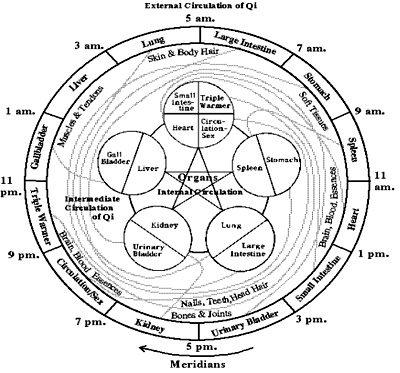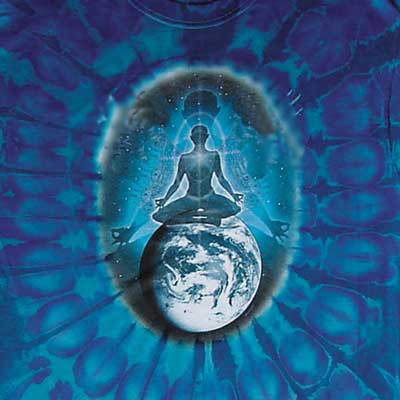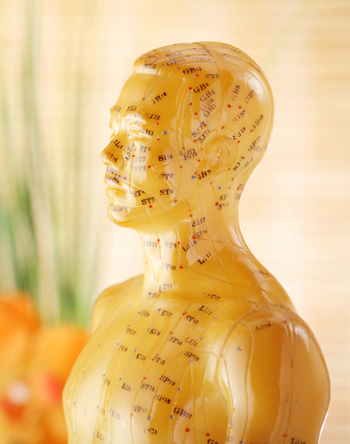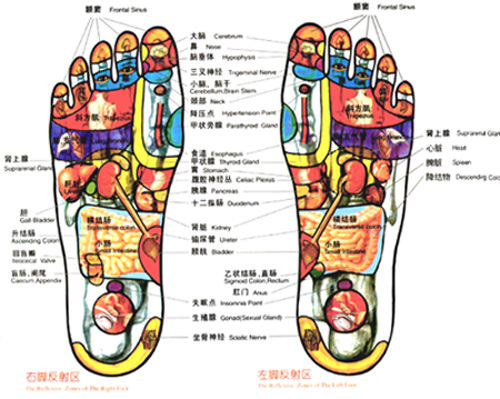Link Between Chinese Ancient Philosophy and TCM:

Taoist healing sciences have been incorporated into a broad spectrum of
medical practices and treatments over the past 3,000 years and are collectively
known as Traditional Chinese Medicine (TCM). The link between early Taoists and
TCM is evidenced in Confucius' quotation, "A man without persistence will never
make a good Taoist or a good physician."
Qi and Blood

Qi is the source of all movement. Qi is the source of all heat.
Chinese medicine is concerned with qi. We study where it comes from, where
it goes, and how it flows. Your body is nourished by, cleansed by, and dependent
on flows. Think of your qi as all your body's energies, electrical, chemical,
magnetic, and radiant. Matter and energy, (flesh and qi), are governed by
natural law. Natural forces such as gravity, time, inertia, friction, yin, and
yang, all affect us, inside and out. Qi must flow. Movement shows that qi
exists. Warmth shows that qi is present. There are many kinds of qi. There's qi
of the channels and qi of the collateral channels, protective qi, digestive qi,
central qi, and original qi. There's normal qi and perverse qi, kidney qi and
lung qi and liver qi (every organ has its own qi). Qi and blood nourish the
body. Qi moves the blood, and blood is mother of the qi. Normal flows of qi and
blood are the basics of good health. When they are abundant and flowing, we are
well. When blood or qi is weak or stuck, we become ill.
Theory of Yin and Yang

Yin and Yang describe change. Yin and Yang refer to the sides of a mountain. In the morning, one side is in shade, the other in sunlight. Later in the day, the sides have reversed. Dark becomes light and light becomes dark. Nature is like this, forever changing, undulating. In time, Yang turns to Yin. Yin predictably becomes Yang. Change is certain, a basic law of nature you can count on, like gravity. Yang and Yin support one another as they oppose each other. There is always yin within yang and yang within yin. You simply can' t have one without the other. We see the body and its disharmonies in changing shades of Yin and Yang. This helps to understand where events come from and where they are going. This helps to understand the disease and the patient.
The Channels and the Acupoints

Much of our qi energy flows along fourteen major channels and numerous minor channels. These flows influence the flow of all our fluids and energies. Each one of these flows passes through and influences an internal organ. Typically, these rivers of energy are named according to the internal organs, which they nourish. Thus we have the Liver Channel, Stomach Channel, Heart channel, etc. To the acupuncturist, these channels provide access to the internal organs. Most of the 500 or so acupuncture points lie on major channels. Acupuncture points are used to regulate flow along these channels. The most powerful points on these channels lie on the extremities - below the elbows and knees. Five powerful points on the extremity of each channel are known as the five Shu points. They are likened to the flow of water and named the source points, well points, stream points, river points, and sea points.
Theory of the Organs

The organs are more than flesh and blood. They also perform tasks involving the qi. Since we are, in part, about energy (qi), we obviously must have ways of using or managing it. In TCM, we attribute the creation, storage and circulation of qi to some of the internal organs. Chinese medical theory groups the organs into pairs. The Yin organs - (the heart, spleen, lungs, kidneys, and liver) are called the Zang are considered the most important. They are structurally solid, and responsible for the creation and storage of qi and Blood. The Yang organs, (large intestine, small intestine, stomach, gall bladder, and urinary bladder) are called the Fu and are considered less important. They are hollow organs, responsible mainly for the transportation of food and for elimination. There is sixth pair of organs known as the Pericardium and Triple-Heater. These are conceptual organs. They have protective and energetic attributes, but no actual mass.
The Five Elements

A Storm in the Mountains and the Valley is Flooded
It is obvious that the
organs are dependent on one another. The Five Elements is a theory that helps us
to understand these relationships. According to this principle, there exist five
elemental types. These elements are known as Fire, Earth, Metal, Water, and
Wood. Each element relates to the other according to two cycles of influence.
Disharmony in one element will thus create disharmony in others according to
these cycles.
1. The generating cycle (clockwise affecting the next element), for
example, the Liver, overheated by anger, can attack the heart,
2. The
checking cycle (counter clockwise, skipping over the preceding element). For
example, Kidneys, weakened by overwork can cause Insomnia from Heart Fire.
Each type also corresponds to a major organ system. Each type also has corresponding tastes, colors, odors, and emotions. Some of these correspondences are:
1 - Fire/ Red/ Heart/ Joy/ Bitter/ Scorched (acrid)
2 - Earth/ Yellow/
stomach/ Spleen/ Worry/ Sweet/ Fragrant
3 - Metal/ White/ Lungs/ Grief/ Hot/
Fleshy
4 - Water/ Black/ Kidneys/ Fear/ Salty/ Putrid
5 - Wood/ Green/
Liver/ Anger/ Sour/ Rancid